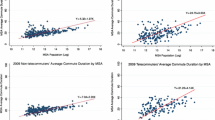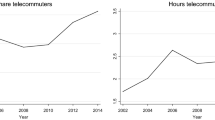Abstract
To understand whether telecommuting could be part of the policy solutions for greenhouse gas (GHG) reduction in the transportation sector, this study uses instrumental variable Tobit models and data from 2001 and 2009 National Household Travel Surveys to explore whether telecommuting reduces or increases the daily work and non-work vehicle miles traveled (VMT). Our findings suggest telecommuters have more VMT for both daily work and non-work trips than non-telecommuters. Adding the findings that telecommuting has no impact on other non-working household member’s daily total (non-work) trips, we can possibly argue that households with telecommuter(s) tend to have higher daily total VMT. Our estimated marginal effect of telecommuting on worker’s daily total trips indicates that a telecommuter on average travels 38 vehicle miles more on a daily basis in 2001 and 45 vehicle miles more in 2009 compared with a non-telecommuter. These increases in VMT translate into a rather large increase in GHG emissions in the US equivalent to adding 7,248,845 cars in 2001 and 8,808,165 in 2009 to the road. Moreover, the difference of this marginal effect between 2001 and 2009 suggests the impact of telecommuting on worker’s daily total VMT had increased over time. With the emerging work arrangements to work from home, telecommuting has been welcomed in this changing environment, not only by individual workers and employers but also policymakers. But the outcomes seem to be opposite to what policy makers may have expected for GHG emission reductions.
Similar content being viewed by others
Notes
Note that “to/from work” trips include commuting trips, lunch trips, and other trips such as coffee breaks.
We use the term “workers with a telecommuting option” to emphasize the fact that some telecommuters did not telecommute on the day of the trip diary.
The first-stage regression results are provided in ESM.
We have also tested Tobit models which include those 0 non-work trip VMT cases for non-workers, and the impact of telecommuting is still statistically insignificant.
We also estimate the conditional marginal effects (conditional on being uncensored in the IV Tobit models and Tobit models). Our unconditional marginal effects, which take the censoring into account, are higher than the conditional marginal effects. This is because telecommuting not only increases the probability of having various work and non-work trips but also increases the VMT if that trip does happen.
References
Alam JB, Wadud Z, Polak JW (2013) Energy demand and economic consequences of transport policy. Int J Environ Sci Technol 10:1075–1082
Balker T (2005) The quiet success: telecommuting’s impact on transportation and beyond. Reason foundation. California, Los Angeles. http://reason.org/news/show/127673.html. Retrieved 9 Jun 2013
Bound J, Jaeger DA, Baker RM (1995) Problems with instrumental variables estimation when the correlation between the instruments and the endogenous explanatory variable is weak. J Am Stat Assoc 90(430):443–450
Buliung RN (2007) Broadband technology and metropolitan sustainability: an interpretive review. Report available from the University of Toronto focus on research. http://focus.library.utoronto.ca/works/11764. Retrieved 9 Jun 2013
Coroama VC, Hilty LM, Birtel M (2012) Effects of internet-based multiple-site conferences on greenhouse gas emissions. Telemat Inform 29(4):362–374
Cox W (2009) Improving quality of life through telecommuting. The informational Technology and Innovation Foundation, Washington DC
Cuenot F, Fulton K, Staub J (2012) The prospect for modal shifts in passenger transport worldwide and impacts on energy use and CO2. Energy Policy 41:98–106
EPA (2011a) Inventory of U.S. greenhouse gas emissions and sinks: 1990–2009 (April 2011). USEPA #430-R-11-005. http://www.epa.gov/climatechange/emissions/downloads11/GHG-Fast-Facts-2009.pdf. Retrieved 23 Nov 2011
EPA (2011b) Office of transportation and air quality. EPA-420-F-11-04, December 2011. Questions and answers: greenhouse gas emissions from a typical passenger vehicle. http://www.epa.gov/otaq/climate/documents/20f11041.pdf. Retrieved 8 Jun 2013
EPA (2013) Light-duty automotive technology, carbon dioxide emissions, and fuel economy trends: 1975 through 2012. Appendix A database details and calculation methods (March 2013). http://www.epa.gov/fueleconomy/fetrends/1975-2012/420r13001-appx-a.pdf. Retrieved 12 Feb 2014
Fox M (1995) Transport planning and the human activity approach. J Transp Geogr 3(2):105–116
Fragkias M, Lobo J, Strumsky D, Seto KC (2013) Does size matter? Scaling of CO2 emissions and U.S. urban areas. PLoS One 8(6):e64727. doi:10.1371/journal.pone.0064727
Fuhr JP, Pociask S (2011) Broadband and telecommuting: helping the U.S. environment and the economy. Low Carbon Econ 2:41–47
Greene WH (1997) Econometric analysis, 3rd edn. Prentice Hall, Upper Saddle River, NJ
Hall AR, Rudebusch GD, Wilcox DW (1996) Judging instrument relevance in instrumental variables estimation. International Economic Review 37(2):283–298
Holden E, Linnerud K (2011) Troublesome leisure travel: the contradictions of three sustainable transport policies. Urban Stud 48(14):3087–3106
Horvath A (2010) Environmental analyses of telework: what we know, and what we do not know and why? In: Paper presented at the 2010 IEEE international symposium on sustainable systems and technology 17–19 May 2010; Arlington, VA
IEA (2008) Energy and technology perspectives 2008: scenarios and strategies in 2050. International energy agency, Organization for Economic Co-operation and the Development (OECD); Paris, France
Jones CM, Kammen DM (2011) Quantifying carbon footprint reduction opportunities for U.S. households and communities. Environ Sci Technol 45:4088–4095
Kate L, Harnish T (2011) The state of telework in the U.S.; how individuals business and government benefit. Telework Research Network, San Diego
Khan A (2010) Telecommuting as a strategy for reducing energy consumption and greenhouse gas emissions in multi-nucleated urban regions. In: 12th WCTR 11–15 July; Lisbon, Portugal
Kitou E, Horvath A (2003a) Energy related emission from telework. Environ Sci Technol 37(16):3467–3475
Kitou E, Horvath A (2003b) Transportation choices and air pollution effects of telework. J Infrastruct Syst 12(2):121–134
Kitou E, Horvath A (2008) External air pollution costs of telework. Int J Life Cycle Manag 13(2):155–165
Liao CH, Chang CL, Su CY, Chiueh PT (2013) Correlation between land-use change and greenhouse gas emissions in urban areas. Int J Environ Sci Technol 10:1275–1286
Markus M, Andrey J, Johnson LC (2006) The sustainability of telework: an ecological-footprinting approach. Sustain Sci Pract Policy 2(1):3–14
Marletta P, Pasquini A, Stacey G, Vicario L (2004) The environmental impact of ISTs, E-living project report
Matthews HS, Williams E (2005) Telework adoption and energy use in building and transport sectors in the United States and Japan. J Infrastruct Syst 11(1):21–30
McCollum D, Yang C (2009) Achieving deep reductions in US transport greenhouse gas emissions: scenario analysis and policy implications. Energy Policy 37:5580–5596
Nelson P (2004) Emissions trading with telecommuting credits: regulatory background an institutional barriers. Resources for the future, Washington
Nelson D, Niles J (2000) Observations on the causes of nonwork travel growth. In: Transportation research board paper. No. 00-1242, 79th annual meeting, Jan 9–13, Washington, DC
New York Times (2011) Carmakers back strict new rules for gas mileage. By Bill Vlasic Published: 28 July 2011. http://www.nytimes.com/2011/07/29/business/carmakers-back-strict-new-rules-for-gasmileage.html?pagewanted=all. Retrieved 23 Nov 2011
Roth KW, Rhodes T, Ponnum R (2008) The energy and greenhouse gas emission impacts of telecommuting in the U.S. proceedings from the 2008 IEEE international symposium on electronics and the environment, pp 1–6
Santos G, Behrendt H, Teytelboym A (2010) Part II: Policy instruments for sustainable road transport. Res Transp Econ 28:46–91
Shafizadeh KR, Niemeier DA, Mokhtarian PL, Salomon I (2007) Cost and benefits of home-based telecommuting: a Monte Carlo simulation model incorporating telecommuter, employer, and public sector perspectives. J Infrastruct Syst 13(1):12–25
Shea J (1997) Instrument relevance in multivariate linear models: a simple measure. Rev Econ Stat 79:348–352
Srinivasan S, Ferreira J (2002) Travel behavior at the household level: understanding linkages with residential choice. Transp Res Part D: Transp Environ 7(3):225–242
Staiger D, Stock JH (1997) Instrumental variables regression with weak instruments. Econom 65(3):557–586
Steve W, Bishins A, Kooshian C (2009) Cost-effective GHG reductions through smart growth and improved transportation choices: an economic case for investment of cap-and-trade revenues. Center for Clear Air Policy, Washington
Strathman JG, Dueker KJ, Davis JS (1994) Effects of household structure and selected travel characteristics on trip chaining. Transp 21:23–45
Tang W, Mokhtarian PL, Handy S (2011) The impact of the residential built environment on work at home adoption and frequency: an example from Northern California. J Transp Land Use 4(3):3–22
Tayyaran MR, Khan AM (2003) The effects of telecommuting and intelligent transportation systems on urban development. J Urban Technol 10(2):87–100
Urban Land Institute (2009) Moving cooler: an analysis of transportation strategies for reducing greenhouse gas emissions. Urban Land Institute, Washington
U.S. Bureau of Labor Statistics (2012) Labor force statistics from the current population survey data, 2009 annual average-house data-tables form employment and earnings. In: Employment status of the civilian noninstitutional population, 1940s to date. http://www.bls.gov/cps/cps_aa2009.htm. Retrieved 24 July 2012
Zhu P (2011) Telecommuting, travel behavior and residential location choice: can telecommuting be an effective policy to reduce travel demand? Ph.D. Dissertation, University of Southern California
Zhu P (2012) Are telecommuting and personal travel complements or substitutes? Ann Reg Sci 48(2):619–639
Zhu P (2013) Telecommuting, household commute and location choice. Urban Stud. doi:10.1177/0042098012474520
Acknowledgments
We want to thank the editor and reviewers for their comments.
Author information
Authors and Affiliations
Corresponding author
Electronic supplementary material
Below is the link to the electronic supplementary material.
Rights and permissions
About this article
Cite this article
Zhu, P., Mason, S.G. The impact of telecommuting on personal vehicle usage and environmental sustainability. Int. J. Environ. Sci. Technol. 11, 2185–2200 (2014). https://doi.org/10.1007/s13762-014-0556-5
Received:
Revised:
Accepted:
Published:
Issue Date:
DOI: https://doi.org/10.1007/s13762-014-0556-5




